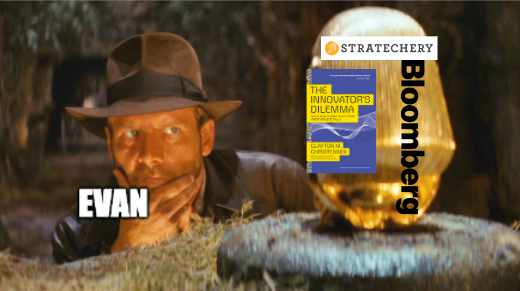
Sponsored By: Sunsama
This essay is brought to you by Sunsama, your personal assistant for deep work.
All entrepreneurs want to know how to win. Investors all want to know how to pick winners. The issue is that no one can really agree how to do either.
Depending on who you talk to, you’ll hear different gospels espoused. Some are devotees of the cult of the founder. For such an adherent, there are entire publications all devoted to the study of successful people.
Simultaneously, there are those who prefer the magic of ⭐frameworks⭐. Their divine prophets are thinkers like Clayton Christensen and Michael Porter. This kind of thinking makes sense to me! Surely there is a “right way” to build a billion dollar company.
For many years, I felt like I was just on the cusp of understanding the secret. I was an archaeologist, digging through hundreds of books—company profiles, strategy theory, biographies of founders—to find the buried treasure of truth. I religiously read all the newsletters people told me to subscribe to, listened to the podcasts by all the greats, and tried to understand the “why” behind the headlines. I was driven by this deep hunger to understand.
Now, ~10 years into this journey, I have started to form a new thesis that runs somewhat contrary to existing methods of evaluation.
I would propose that the secret to building a successful technology company is culture-market fit. Culture-market fit (CMF) is that blissful intersection of an opportunity in the market with a culture that can execute on said opportunity. Allow me to clarify: CMF occurs when an organization matches with an opportunity, and the organization’s culture allows the right strategies and process to occur allowing them to capture said opportunity. Sometimes that will mean giving employees lots of freedom (Google), and sometimes that will mean micro-managing people (Amazon), but the important thing is that the culture cultivated correctly addresses the market opportunity. A company’s culture is a vibe, an ethos, that permeates every slide deck, every product decision, every analysis. When there is no clear right answer (which is always) the culture-market fit is what drives decisions.
Culture-market fit does not mean that the organization is hyper-aligned with customer interests, either. CMF is determined by crafting the internal culture that wins the external market. Sometimes that is aligned with customers, but sometimes it is also done through more…company-oriented decisions. Exxon and Chevron and nearly every Big Bank regularly screw over their customers but are still fiscally successful over an extended period. Some companies are motivated by ethos, some by greed, some by hubris, but all winners match their culture and incentives to the market they are serving. A market opportunity is where a business can extract the most long-term profits, not necessarily the one that gives customers the goods or services they would most prefer. Empowered founders are important and so are strategy planning sessions, but they are all cultural outputs.
If I am correct, then this framing has important implications for capital deployment inside of organizations and in which startups are best for funding. I want to emphasize something: I recognize how pie-in-the-sky, non-numeric this idea is. It is not as intellectually soothing as a perfectly crafted chart or spreadsheet. However, I’m increasingly convinced that businesses are made in the ugly, daily, poorly illuminated decisions. In those times, it isn’t spreadsheets that wins—it’s culture-market fit.
TL;DR
- Culture-market fit is more important than product-market fit because it precludes any product decision
- Culture is the deep understanding of your customers, the people you hire to serve those customers, and the approach those individuals use to serve customers
- Having CMF means that your organization’s design, product, and operating mandate match the market opportunity
Culture-market fit > Product-market fit
For every successful deployment of a strategy theory working or a founder archetype succeeding, I can find an equally successful strategy or founder taking the exact opposite approach. This conundrum is at the heart of the problem.
Take product-market fit, for example. If you were to ask 50 people what product-market fit is you would get 50 different answers. As with everything in startup linguistics, it is more handwavy than definitionally firm. Roughly speaking, it is when the product you have made resonates deeply with the customers you are targeting. This resonance can manifest itself in accelerated revenue growth, customer demand, etc.
Allow me to offer 3 examples of PMF, all of which took entirely different paths to get there:
- Figma (acquired for ~$20B) spent 4 years building their product before publicly launching. Product was made via a whiteboard session.
- The Apple 1 came to be almost magically. Wozniak said that after attending a hobbyist computer club meeting “this whole vision of a personal computer just popped into my head.” Within a few months, he completed the prototype entirely on his own. Jobs sold 50 of those computers before he even had made anything more than a prototype.
- Superhuman (an email client) took 3 years before the founder would believe that they had product-market fit. Interestingly he said, “We found pockets of PMF with specific segments of founders, managers, executives and business development professionals. Once we recognized this, we were able to focus the entire company on serving that narrow segment better than anybody else.”
These stories are compelling to me because they all represent radically different methods of building winners. Figma was a turtle, hiding in its shell while it tinkered. Apple, a stroke of genius. Superhuman, a steady grind upwards. Every startup success story has a point of PMF, but all of them took a different path to get there. PMF matters but it is the output, not the input of success.
The Only Subscription
You Need to
Stay at the
Edge of AI
The essential toolkit for those shaping the future
"This might be the best value you
can get from an AI subscription."
- Jay S.
Join 100,000+ leaders, builders, and innovators

Email address
Already have an account? Sign in
What is included in a subscription?
Daily insights from AI pioneers + early access to powerful AI tools











Comments
Don't have an account? Sign up!